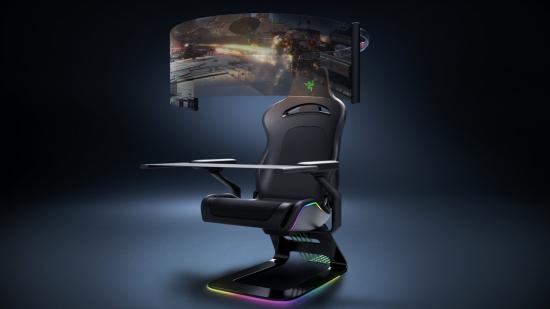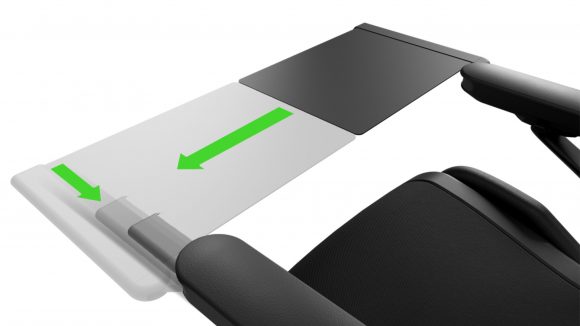Razer and CES go together like cookies and cream, allowing the snake-headed company’s mad scientists to come out and show their answers to the question ‘what if…?’. This year, the firm has imagined what could be considered the perfect next-generation gaming setup in the form of a Razer gaming cockpit, dubbed ‘Project Brooklyn’.
If you’re unfamiliar with gaming cockpits, they often act as all-in-one gaming chairs with a built-in desk at your fingertips, suspended monitors for ultimate immersion, and sometimes additions like footrests and cup holders. Just think of the perfect e-racing or flight simulator. The problem up until this point, aside from the four-figure cost they usually ship with, is the amount of space they take up.
Instead of using the gaudy scorpion tail design to dangle multiple displays like the Acer Predator Thronos, Razer’s Project Brooklyn opts for a more understated approach, hinging on a single 60-inch foldable OLED display that gives seamless panoramic vision and can be tucked away into the body of the chair at the press of a button when not in use.
Similarly, the built-in desk meant for your keyboard and mouse neatly packs away into the modular 4D armrests, making the chair apt for both console and PC gaming. You could always use it to place a drink on if you own an Xbox Series X or PlayStation 5, however.
In fact, when everything’s put away, Project Brooklyn is almost indistinguishable from the Razer Iskur gaming chair the foundations are based on, with a leather-stitched seat and carbon fiber body. The main giveaways that this is a different model are the inclusion of RGB lighting around the seating area, interruption in the headrest gap, and haptic feedback – although you wouldn’t know the latter at a glance.

With the Iskur releasing in October, this might seem like a big leap forward, but Razer has been musing about the concept as far back as 2018 when the Razer Nari Ultimate brought haptic feedback into a headset.
Sadly, no prototypes exist yet, but the idea is for everything to connect to the game you’re playing, with the lighting and haptic feedback reacting to what’s on screen. At the very least, this concept wasn’t announced on April Fools’ Day like the Razer toaster, so there’s hope we might see Project Brooklyn come to life yet.

